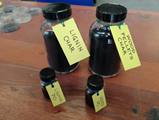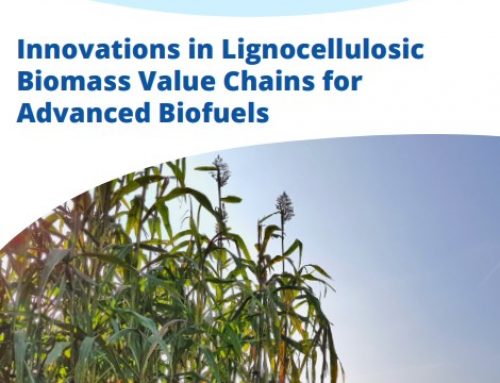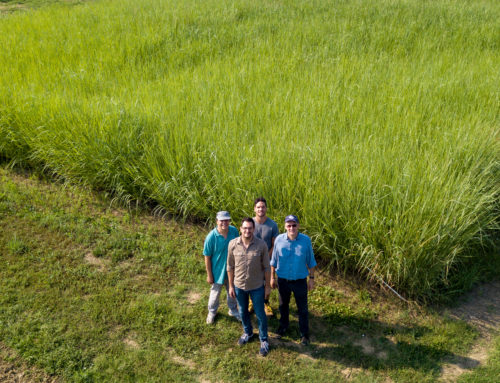The gasification of biomass to produce advanced biofuels via Fischer-Tropsch is a well-known process and has been a subject of research and of industrial demonstration for many years. Lignocellulosic biomass is a challenging feedstock for gasification, especially when it is obtained from crop residues and herbaceous crops. The main barriers consist in the difficulty to handle the solid fibrous feedstock for feeding the gasifier, and the high content of chlorine, alkali and other compounds, which contribute to generate tars during gasification.
For this reason, in BECOOL the gasification of fast-pyrolysis bio-oil (FPBO) obtained from solid biomass is being investigated as an alternative conversion pathway to the direct gasification of biomass. The use of FPBO instead of solid biomass has the advantages of an easier handling of the liquid feedstock, an energy densification of the bio-oil about 5 times than the raw biomass, and a low ash content (the ashes are separated from the oil during the fast pyrolysis process). All of these aspects significantly contribute to increase the overall efficiency of the biomass conversion pathways.
A blend of char and bio-oil
 In addition to the gasification of bio-oil, a potential strategy to increase valorize also the solid pyrolysis products (i.e. char) in a single, stable-phase energy carrier, is the combination between bio-oil and char in a slurry. The slurry consists of a highly loaded suspension of solid particles in a liquid phase, with a higher energy density than pure bio-oil.
In addition to the gasification of bio-oil, a potential strategy to increase valorize also the solid pyrolysis products (i.e. char) in a single, stable-phase energy carrier, is the combination between bio-oil and char in a slurry. The slurry consists of a highly loaded suspension of solid particles in a liquid phase, with a higher energy density than pure bio-oil.
In this context, partner RE-CORD is investigating the use of formulations of slurries made by a mix of the liquid and the solid products of different pyrolysis processes of wood. These are made respectively with intermediate pyrolysis charcoal (IPC) in intermediate pyrolysis bio-oil (IPBO) and slow pyrolysis charcoal (SPC) in fast pyrolysis bio-oil (FPBO). The objective is to produce a slurry suitable for gasification, composed by char and FPO bio-oil derived from the pyrolysis of lignocellulosic material.
 At present, the research is focused on the methodology for the preparation of the slurries and their characterization, with the aim of studying the slurring ability of various samples at different char-in-oil contents. The apparent viscosity of the slurry depends on the solid loading (5 – 30 % in mass fraction), the char particle size, and the temperature (up to 60 °C, to prevent bio-oil degradation). The produced formulations were compared against each other, and a defined char-in-liquid content was selected for its use as an intermediate energy carrier. The samples were analyzed to determine chemical and physical properties, phase stability, rheological properties and thermogravimetric analysis.
At present, the research is focused on the methodology for the preparation of the slurries and their characterization, with the aim of studying the slurring ability of various samples at different char-in-oil contents. The apparent viscosity of the slurry depends on the solid loading (5 – 30 % in mass fraction), the char particle size, and the temperature (up to 60 °C, to prevent bio-oil degradation). The produced formulations were compared against each other, and a defined char-in-liquid content was selected for its use as an intermediate energy carrier. The samples were analyzed to determine chemical and physical properties, phase stability, rheological properties and thermogravimetric analysis.
Results
 Preliminary results showed that the organic fraction of IPBO has similar characteristics to FPBO, while the SPC has a significant higher energy content than the IPC. In order to have the best slurry formulation, the testing campaign assumed the FPBO as the representative component for the liquid phase and the SPC for the solid phase. The properties of the slurry are affected by the char content, the particle size and the temperature: by increasing the char-in-liquid fraction, the energy density increases as well as the dynamic viscosity. However, the slurry showed a pseudo-plastic behavior, that maintains a good slurry-ability at 10/90 % in mass fraction wet basis of char/FPBO. No significant differences were observed by varying the char particle size, and the thermogravimetric analysis showed a linear correlation between the solid-in-liquid content of the slurry with respect to the thermal degradation.
Preliminary results showed that the organic fraction of IPBO has similar characteristics to FPBO, while the SPC has a significant higher energy content than the IPC. In order to have the best slurry formulation, the testing campaign assumed the FPBO as the representative component for the liquid phase and the SPC for the solid phase. The properties of the slurry are affected by the char content, the particle size and the temperature: by increasing the char-in-liquid fraction, the energy density increases as well as the dynamic viscosity. However, the slurry showed a pseudo-plastic behavior, that maintains a good slurry-ability at 10/90 % in mass fraction wet basis of char/FPBO. No significant differences were observed by varying the char particle size, and the thermogravimetric analysis showed a linear correlation between the solid-in-liquid content of the slurry with respect to the thermal degradation.
Additional tests of different slurries are planned for this year, with the aim to prepare a final sample for the gasification trials during the last two years of the project.







